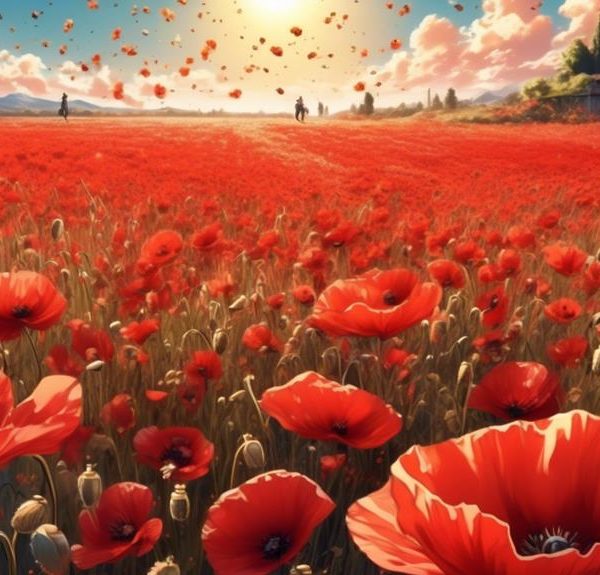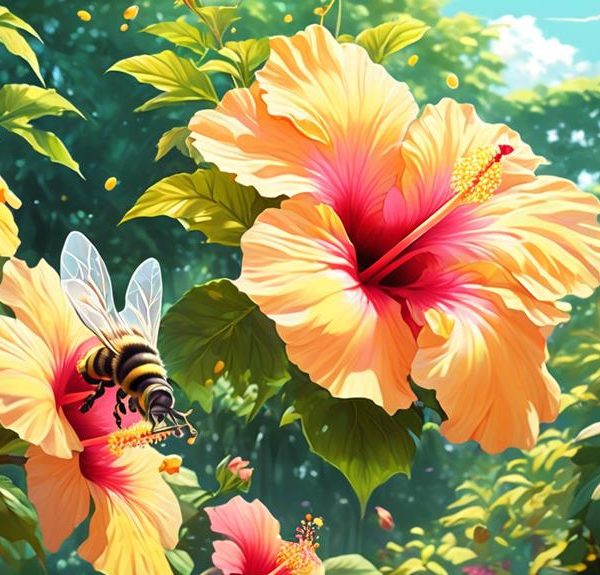Start a captivating exploration of whether bees are as enchanted by butterfly bushes as their fluttering counterparts, and discover what this means for your garden.
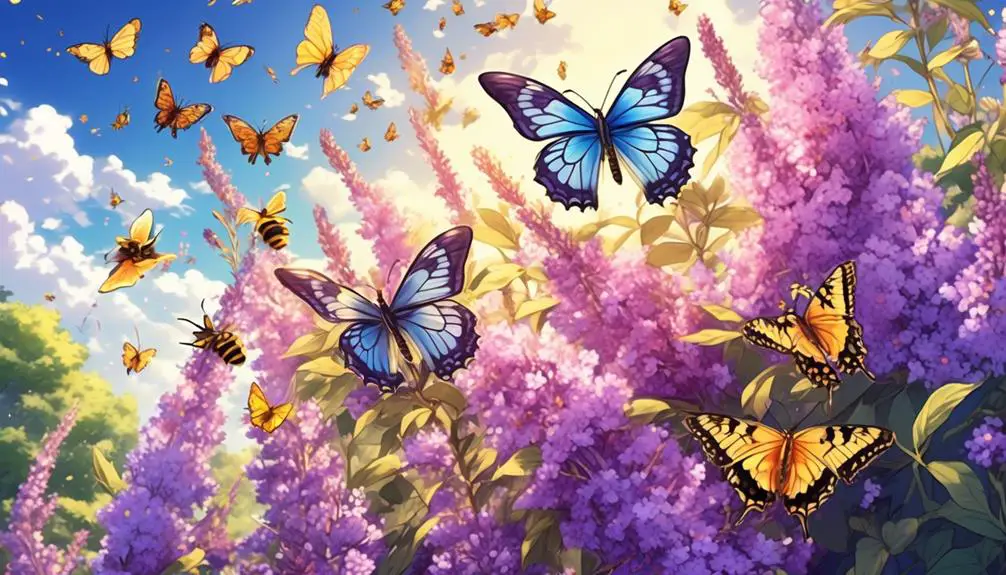
Do Bees Like Butterfly Bushes?
You've likely seen bees buzzing around your garden, drawn to the vibrant colors and sweet nectar of various plants. You've probably also noticed the striking beauty of butterfly bushes, with their lush, elongated flowers swaying gently in the breeze. But the question lingers: do bees, like butterflies, find these particular bushes irresistible?
As a diligent gardener or a nature enthusiast, understanding the intricate relationships between plants and insects can be a fascinating journey. Let's explore, then, whether butterfly bushes are truly as appealing to bees as their name might suggest, and what this could mean for your garden.
Key Takeaways
- Butterfly bushes are attractive to bees due to their vibrant purple, blue, or white blooms and their fragrant, honey-like aroma.
- Bees are drawn to the high volume of nectar produced by butterfly bushes, which serves as a primary food source for them.
- Butterfly bushes play a role in supporting bee survival and their essential task of pollination by providing an abundant source of nectar.
- However, butterfly bushes do not provide bees with pollen, which is a critical component of their diet, and their proliferation can have negative impacts on native plants and the overall ecosystem.
Understanding the Butterfly Bush
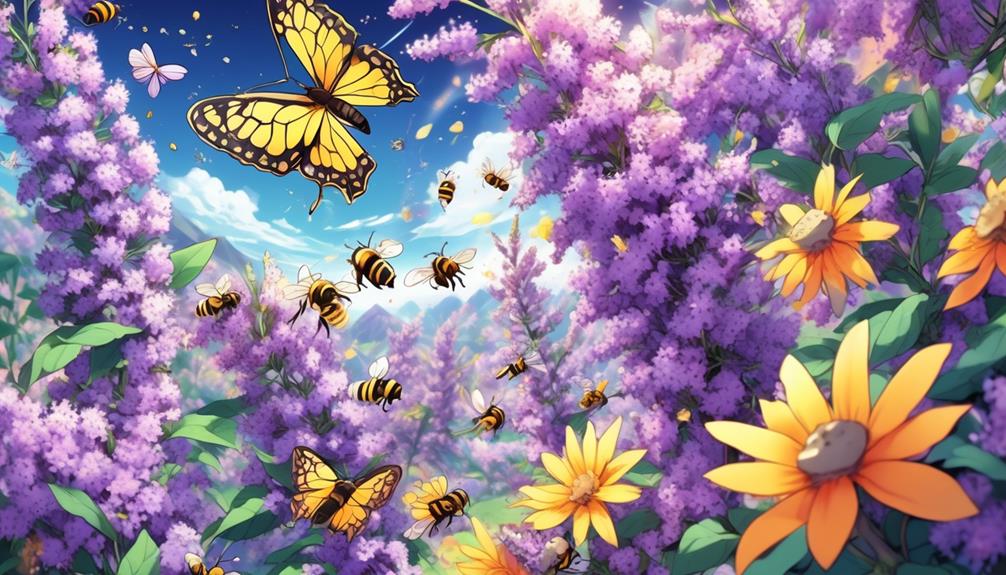
To fully grasp why bees might be attracted to butterfly bushes, you first need to understand the unique characteristics of this vibrant plant. Butterfly bushes, scientifically known as Buddleja davidii, are native to central China and Japan. They're known for their bright, fragrant blooms that appear in the summer and fall, creating a feast for the eyes and nose.
What's particularly intriguing about these plants is their nectar production. Butterfly bushes produce a large amount of nectar, which is a sugary fluid that bees, butterflies, and other pollinators can't resist. This nectar is rich in sucrose, a type of sugar that provides energy for these insects.
Furthermore, the color and shape of the blooms are designed to attract pollinators. They're often vibrant purple, blue, or white, which are colors that bees can see. The tubular shape of the flowers also makes it easy for bees and other insects to access the nectar.
Another notable characteristic is their pollen production. Although not as significant as the nectar, the pollen still provides an additional food source for bees.
Attraction Factors for Bees
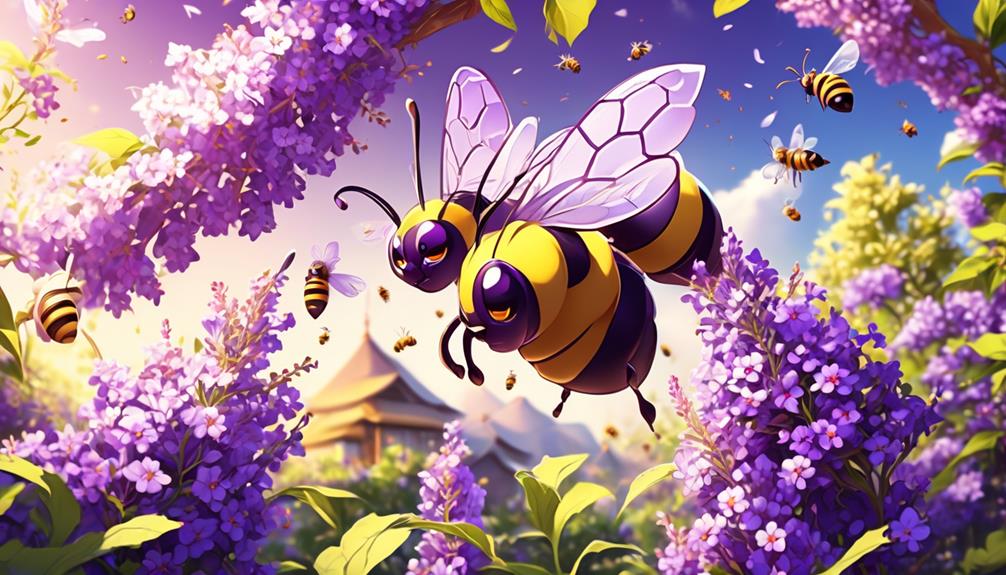
Building on the butterfly bush's appealing traits, let's examine the specific factors that make bees gravitate towards these plants.
First, consider the color. Bees are most attracted to flowers in the blue to violet range. Butterfly bushes typically fall into this spectrum, enhancing their allure for these pollinators.
Second, focus on the scent. Bees have an excellent sense of smell, and the fragrant, honey-like aroma of butterfly bushes is irresistible to them. This aromatic appeal often lures bees from great distances.
Next, think about the nectar. Butterfly bushes produce a high volume of nectar, which is a primary food source for bees. This rich treat, coupled with the bush's long blooming period, ensures a steady food supply.
Lastly, examine the flower structure. Butterfly bushes have tubular flowers, a preferred shape for bees, as it allows easy access to nectar and pollen.
Butterfly Bushes and Bee Pollination
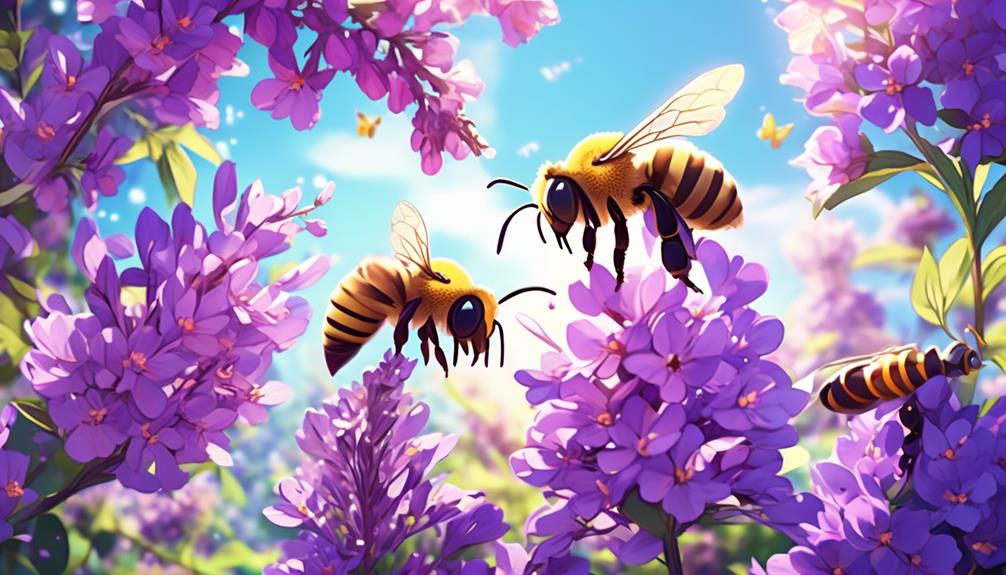
Delving into the role of butterfly bushes in bee pollination, you'll find these plants serve as a critical part of the ecosystem, supporting bees in their essential task of pollination. Butterfly bushes, scientifically known as Buddleia, are prolific bloomers that provide an abundant source of nectar. This nectar attracts bees and offers them a rich feeding ground, thus playing a significant role in their survival.
But there's a twist. Despite their attractiveness to bees, butterfly bushes aren't the best plants for supporting bee populations. Why? They're classified as invasive species in many regions. This means they can outcompete native plants that bees rely on for a balanced diet.
Moreover, butterfly bushes don't provide bees with pollen, a critical component of a bee's diet. Pollen offers essential proteins and fats that nectar lacks. So, while bees are attracted to the bountiful nectar of butterfly bushes, they're not getting a balanced diet, which can impact their health and pollination efficiency.
Potential Risks to Bees
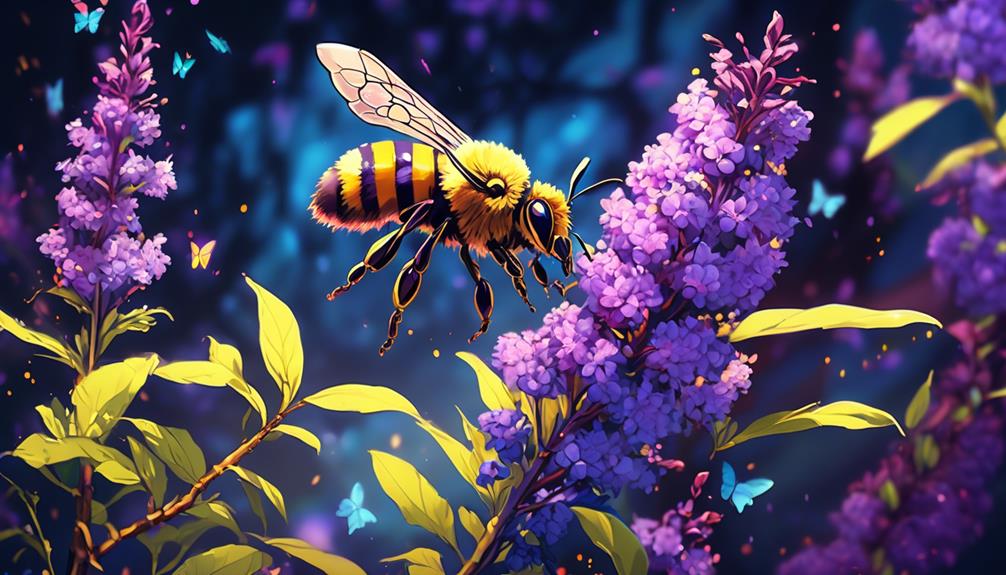
While the nectar-rich butterfly bushes certainly bring bees buzzing, the lack of pollen can pose a considerable risk to their overall health and survival. You see, bees need pollen as a protein source. Without it, they can't produce bee bread, a vital food source for their larvae. Butterfly bushes, while attractive to bees, don't provide them with this necessary component.
Another risk is the non-native nature of butterfly bushes. They can out-compete native plants that provide year-round food and habitat for bees. This displacement can lead to a decrease in local bee populations.
Here's a table to highlight these potential risks:
Risks to Bees | Explanation |
|---|---|
Lack of Pollen | Bees can't produce vital food source for larvae |
Non-native Plant | Can out-compete native plants providing year-round food |
Monoculture | Lack of plant diversity can lead to malnutrition |
Pesticide Exposure | Butterfly bushes may be treated with harmful chemicals |
Habitat Disruption | Butterfly bushes can take over habitats of other beneficial plants |
Alternatives to Butterfly Bushes
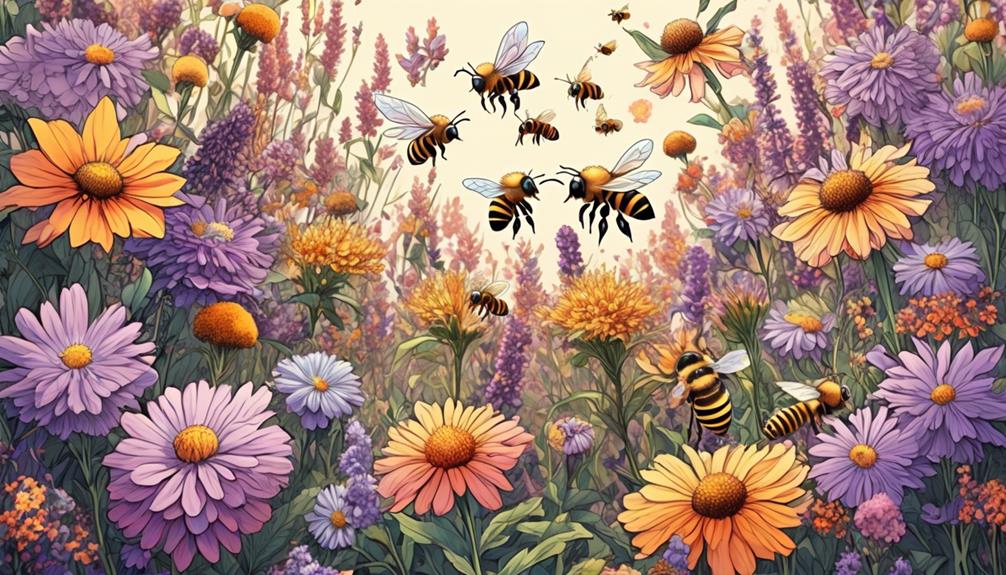
To mitigate the potential risks butterfly bushes pose to bees, you might consider planting native species that are rich in both nectar and pollen. Goldenrod, bee balm, and milkweed, for instance, provide a balanced diet that nurtures bee populations.
Selecting plants for your garden isn't just about aesthetics; it's also about building a supportive ecosystem. When choosing alternatives, it's vital to consider bloom times. Native species often bloom in sync with local bee species' life cycles, providing a steady food source.
Let's elaborate on the goldenrod (Solidago spp.). It's a late-summer bloomer, supplying nectar when many other plants have finished flowering. This plant, often mistaken as a weed, is a crucial resource for bees prepping for winter.
Bee balm (Monarda spp.) is another excellent alternative. Its bright, fragrant flowers are rich in nectar, attracting a diverse range of pollinators. Simultaneously, milkweed (Asclepias spp.) is a host plant for monarch butterflies, serving dual purposes.
You're not limited to these options, though. There's a wide array of native plants available, each with unique benefits. Researching local flora can help you make an informed decision, promoting healthier bee populations and a more vibrant garden.
Frequently Asked Questions
What Other Insects Are Attracted to Butterfly Bushes Besides Bees?
Besides bees, you'll find a variety of insects attracted to butterfly bushes. Butterflies, as the name suggests, are particularly drawn to them. Additionally, you'll see hummingbird moths fluttering around. They're not just for flying creatures either!
Many types of beetles and spiders also make their homes in these bushes. It's truly a hotspot of insect activity. Just remember, while you're observing, don't forget to enjoy the beauty of these interactions!
How Can I Encourage More Bees to Visit My Butterfly Bushes?
To encourage more bees to visit your butterfly bushes, you'll need to make your garden more bee-friendly.
Start by planting a variety of plants that bloom at different times of the year. Bees are particularly attracted to blue, purple, and yellow flowers.
Avoid using pesticides, as these can harm bees.
Provide a source of fresh water, and consider adding a bee house to provide shelter.
Can Butterfly Bushes Survive in a Variety of Climates?
Yes, butterfly bushes can thrive in a variety of climates. They're hardy and adaptable, flourishing in both hot and cold temperatures. However, they do best in full sun and well-drained soil.
If you're in a cooler climate, you'll notice they might die back in winter but will sprout anew in spring. In warmer climates, they'll grow year-round.
It's all about giving them the right care and attention, wherever you're located.
Do Different Species of Bees Have Different Reactions to Butterfly Bushes?
Yes, different species of bees indeed have varying reactions to butterfly bushes. You'd find that honeybees and bumblebees are particularly drawn to these plants as they're attracted to the vibrant colors and sweet nectar.
However, some solitary bees mightn't be as interested. It's crucial to remember that bees' preferences can also be influenced by other factors such as the presence of other plants and their specific ecological needs.
What Are Some Other Plants That Can Attract Bees to My Garden?
Yes, there are numerous other plants you can add to your garden to attract bees.
Lavender's strong scent pulls bees in, while sunflowers offer large, pollen-rich surfaces.
Bees are also drawn to foxgloves and snapdragons, which provide shelter from predators.
Additionally, they love herbs like rosemary and thyme.
Planting a variety of these in your garden won't only attract bees but also help sustain their populations.
Conclusion
So, you've learned that bees are indeed attracted to butterfly bushes due to their abundant nectar and vibrant colors. However, these bushes aren't the best for bee pollination and can pose risks.
It's crucial to consider other plant alternatives for a bee-friendly garden. Understanding the relationship between bees and plants, like the butterfly bush, aids in promoting a healthier environment and supporting our industrious little friends.
Let's keep exploring and learning!

